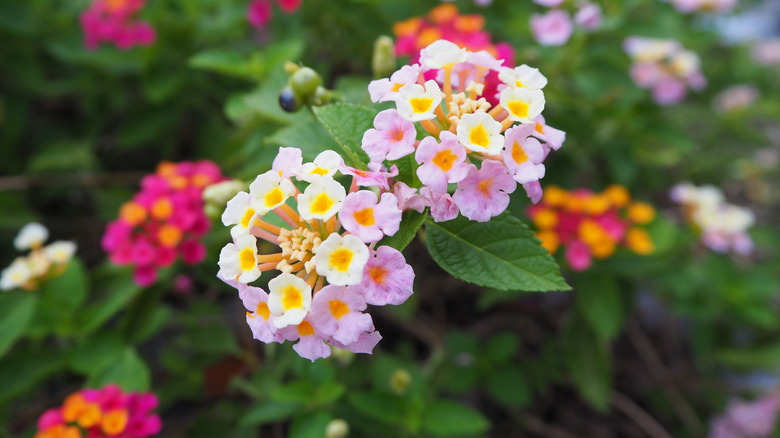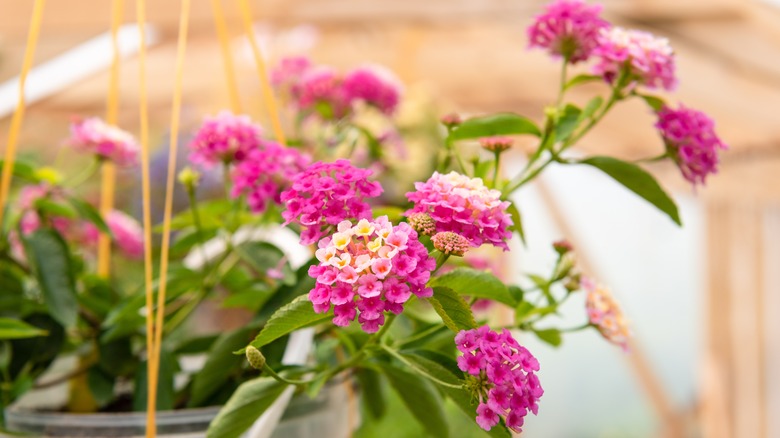Plant Lantana Flowers To Repel Mosquitoes (But Watch Out For One Deadly Downside)
We can all agree mosquitoes are a nuisance. Not only do these pests bite, leaving behind itchy bumps and rashes, but they can also carry diseases. You don't want to deal with them while you're outside, and definitely not when you're in the comfort of your home. Fortunately, there are several mosquito-repellent plants that work to keep your house pest-free, and lantana flowers are one of them. Unfortunately, parts of this warm-weather plant can be deadly.
The common lantana, scientifically known as Lantana camara, has shrub-like foliage with vibrant pink, orange, yellow, and purple flowers. This beautiful plant doesn't just keep mosquitos at bay but also attracts creatures we want around, such as pollinators, butterflies, and hummingbirds. While the vibrant pest-repellent petals are eye-catching, you need to watch out for the flower's toxic leaves, berries, and blooms that can cause various ill symptoms. However, there is a way to safely add lantana flowers to your home for a beautiful, mosquito-free space.
The repellent and pretty but poisonous flower
Research published in the journal Public Library of Science One found 50% fewer mosquitoes in houses with lantana plants compared to those without the pest-repellant flowers. The study also found mosquitoes who ate this plant were less likely to survive. There are a few variables that make the lantana a deterrent to these insects. Its leaves release large amounts of volatile organic compounds that repel the pests. The essential oil made from its leaves also contains eucalyptol, alpha-humulene, and germacrene — all substances that are poisonous to mosquitoes.
Lantana flowers are a plant you'll want to add to your garden if you have a mosquito problem, but it comes with a deadly downside. The flowers, fruit, leaves, and sap are all poisonous to people and pets. In particular, the leaves can cause skin irritation, such as dermatitis, and the berries can be deadly if consumed. It is also poisonous to livestock, such as cattle or sheep, potentially leading to liver failure. It is best to keep the colorful petals away from your beloved animals. Still, with proper precautions, you can safely reap lantana's benefits without needing poison control on speed dial.
The best way to incorporate lantana flowers in your space
Hanging baskets are a great way to add lantana flowers to your indoor or outdoor space while keeping them away from pets and children. This plant can be aggressive with its growth, too, so planting them in a container will help prevent the flowers from invading your entire garden. To successfully grow and take care of lantana plants, place them in an area with full sun or at least six hours of direct sunlight. Moist, well-drained soil is best, along with monthly fertilization during the growing season. Excess water or fertilizer can reduce its blooms, so check the condition of the soil and foliage before adding either.
The ideal place to hang the lantana flowers is around your home's entrance on a porch or awning to help keep mosquitos from invading your abode. You can also strategically place them near mosquito-hot spots like bird baths and gutter pipes to deter the insects from the stagnant water. If it won't be too tempting to touch, these flowers can also be a charming addition to your houseplant collection. Lantana flowers are easy to care for and offer a natural way to repel mosquitoes; just don't forget your garden gloves when handling them.


